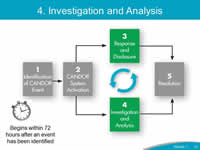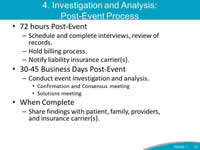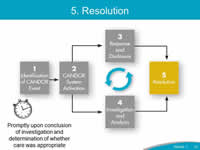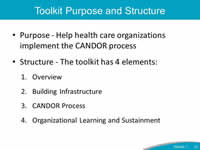Module 1: An Overview of the CANDOR Process
AHRQ Communication and Optimal Resolution Toolkit
Facilitator Notes
|
Say: The CANDOR Toolkit is composed of eight distinct modules that can be used to teach users about the CANDOR process. Module 1 provides an overview of the steps to implement the CANDOR process in health care organizations. The overview module also explains the purpose of the toolkit and how to use it in your organization. |
Slide 1
|
|
Say: Module 1 objectives are to:
Review how to use the CANDOR toolkit to educate health care organizations on how to implement the CANDOR process. |
Slide 2
|
|
Say: CANDOR stands for Communication and Optimal Resolution. The CANDOR process is designed to help health care organizations and practitioners respond to unexpected patient harm events in a timely, thorough, and just manner. The CANDOR process helps hospitals improve their immediate response to harm and realize short- and long-term improvements in the monitoring and reporting of events by promoting candid, empathic communication and timely resolution for patients, caregivers, and the organization. |
Slide 3
|
|
Say: Before we discuss the CANDOR process, it is important to define a CANDOR event. A CANDOR event is an event that involves unexpected patient harm. The unexpected harm can be physical, emotional, or financial. These events trigger the CANDOR process even when a cause for the event is not yet known. Near misses are important and deserve action, but are not CANDOR events. |
Slide 4
|
|
Say: When a CANDOR event occurs, the CANDOR process can be used to introduce a number of actions designed to:
The goals of the CANDOR process are to demonstrate respect for the patients, families, and caregivers impacted by harm and to address many of the quality and safety priorities identified by health care organizations. |
Slide 5
|
|
Do: Say: To better understand the importance of the CANDOR process, let’s watch this introductory video. |
Slide 6
|
|
Say: Implementation of the CANDOR process requires a paradigm shift away from the traditional response of organizations to harm events. This table demonstrates just a few of the changes that must occur to realize the goals of the CANDOR process.
Each of these areas will be discussed in more detail in subsequent modules in this toolkit. |
Slide 7
|
|
Say: Now that we understand the definition of a CANDOR event, let’s briefly examine what occurs during the CANDOR process. The CANDOR process consists of five major “bundles” of activity that proceed in sequence and at times simultaneously. They include: Component 1: Identification of a CANDOR Event. Component 2: CANDOR System Activation. Component 3: Response and Disclosure. Component 4: Event Investigation and Analysis. Component 5: Resolution. On the next slides, we will examine each component of the CANDOR process in more detail. |
Slide 8
|
|
Say: The CANDOR process begins with the Identification of a CANDOR Event. Identification is the critical first step of the process. The organization must work to help clinicians understand what a CANDOR event is and what to do when they recognize that a CANDOR event is occurring or has occurred. Typically, CANDOR events can be identified via verbal communication to risk management/patient safety personnel, a hotline, an electronic reporting system, or other means. Do: Activity: List de-identified events that have occurred in your organization. Ask: Would these events qualify as a CANDOR event? Say: More information on Event Identification and Reporting of a CANDOR event will be discussed in Module 4 of the toolkit. |
Slide 9
|
|
Say: Once a CANDOR event has been reported, the organization should activate the CANDOR Response Team. Activation of the CANDOR Response Team should begin within 30 minutes after a CANDOR event has been identified. Once activated, the CANDOR Response Team will work with the caregivers where the event occurred to ensure that the patient is clinically stable and safe. Then, the CANDOR Response Team or a member of the Event Investigation and Analysis Core Team should begin a preliminary fact-finding investigation. The CANDOR Response Team is also responsible for notifying the CANDOR Communication Lead that a CANDOR event has been identified and providing immediate emotional support to the patient, family, and caregiver, by activating the Care for Caregiver program. After the CANDOR System Activation occurs, the 3rd and 4th components should occur simultaneously. However, for this presentation, we are going to discuss them in order. More information on the CANDOR System Activation processes will be discussed in Module 4 of the toolkit. |
Slide 10
|
|
Say: The 3rd component of the CANDOR process is Response and Disclosure. The Response and Disclosure process begins 60 minutes after a CANDOR event has been identified and continues as more is learned. More detailed information on Response and Disclosure will be discussed in Module 5 of the toolkit. During the Response and Disclosure component, the CANDOR Response Team ensures the CANDOR process activities occur. Ideally, the CANDOR Response Team and/or CANDOR Communication Lead are responsible for the initial communication with the patient and/or family. The CANDOR Communication Lead coordinates all communications, and ensures that all caregivers are consistent in their communication, i.e., that they stay "on message." Following the initial disclosure conversation, the CANDOR Response Team ensures that a trained communicator establishes ongoing regular communication with the patient and/or family. The CANDOR Response Team is responsible for assessing the needs of caregivers involved in the harm event and providing initial emotional support, as well as activating the organization’s Care for the Caregiver program to assess the caregiver’s needs for ongoing support. More information on the Care for the Caregiver program will be discussed in Module 6 of the toolkit. Let’s examine the specific activities that occur during the 4th component of the CANDOR process, Event Investigation and Analysis. |
Slide 11
|
|
Say: The 4th component of the CANDOR process is the Event Investigation and Analysis. This component and the Response and Disclosure component will happen at the same time. This component of the CANDOR process should begin within 72 hours after a CANDOR event has been identified. More information on the Event Investigation and Analysis process will be discussed in Module 4 of the toolkit. |
Slide 12
|
|
Say: Event Investigation and Analysis should be conducted by the Core Team, which we will discuss in more detail in Module 4 of the toolkit. The Event Investigation and Analysis component of the CANDOR process can be broken down into three major parts. The first part begins 72 hours after a CANDOR event has been identified. The following activities should occur at this time: the Core Team will schedule and complete interviews, review records, gather evidence, etc. The Core Team will also notify accounting to “hold the patient’s bill.” This means that the hospital and professional bills will not be processed until after the investigation and analysis of the event has been completed. The final activity is notifying the liability insurance carrier (if any) that a CANDOR event has been identified at the organization. The second part should occur within 30-45 business days after a CANDOR event has been identified. During this time frame, the Core Team will determine causal factors for the event and whether the standard of care was met. After Event Investigation and Analysis are complete, a Confirmation and Consensus meeting and a Solutions meeting will occur. These meetings will be discussed in module 4b. After the internal meetings have been held, the findings and plan of action, including actions taken, should be shared with the patient, family, providers, and insurance carrier(s). Once this is completed, the organization is ready to move on to the Resolution component of the CANDOR process. |
Slide 13
|
|
Say: The final component of the CANDOR process involves the Resolution. Resolution of the event can only occur after Event Investigation and Analysis has been completed. The purpose of the Resolution component is for the organization to engage the patient and family in a discussion about preventing recurrence of similar harm events, and offering compensation for the patient’s harm, when appropriate. This Resolution component of the CANDOR process will be discussed in more detail in module 7 of the toolkit. |
Slide 14
|
|
Say: The purpose of the toolkit is to educate health care organizations on how to implement the CANDOR process. Each of the 8 modules in the toolkit provide educational resources designed to guide leaders and staff who are interested in implementing the CANDOR process in their organization. The toolkit is organized into 4 parts and includes:
There are a number of tools provided to help your organization get started with implementing the CANDOR process. Tools for Module 1 include the:
Introduction to Communication and Optimal Resolution (CANDOR) video—This video explains the intent and benefits of the CANDOR process. |
Slide 15
|


















